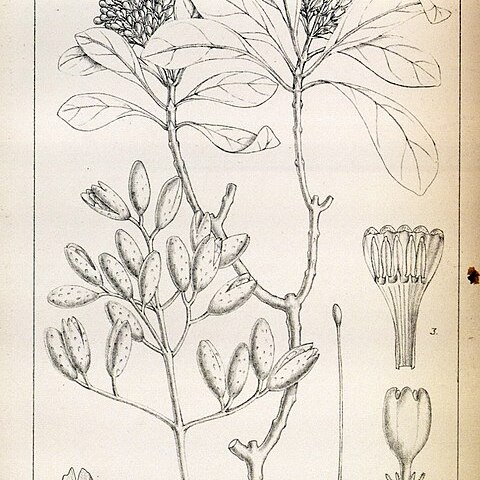Inflorescences terminal, often with additional axillary ones, often numerous at apices of short lateral shoots forming a thyrsoid panicle, 1–8 cm long, the axis glabrescent, pubescent or densely scabrid; flowers very sweetly (unpleasantly fide Greenway) scented; peduncle 0.3–2.5 cm long; pedicels 1.5 mm long; primary bracts not present; secondary bracts 4–6 × 0.3–1.5(3) mm wide, lanceolate, glabrescent, ciliate or scaly-pubescent, deciduous.
Leaf blades 1–9 × (0.4)0.8–4.7(5.9) cm, elliptic to oblanceolate, obtuse to subacuminate at the apex, narrowly cuneate at the base and ± decurrent into the petiole, glabrous to densely covered with scabrid scaly hairs and more rarely thinner pubescence; petiole 0.3–5.5 cm long, often crimson; stipules 2–7 × 2 mm, deltoid or oblong-triangular, sometimes bifid, glabrous.
Corolla white, greenish-white or yellow, sometimes tinged red in bud, sometimes turning black; glabrous or puberulous; tube 2.5–5 mm long, cylindrical below, funnel-shaped above; lobes 5–6, 1.5 × 1 mm, ovate, ciliolate; style 1.4 cm long, exserted from the corolla for about 3–5(7) mm; pollen presenter 0.5 mm long, ellipsoid.
Seeds straw-coloured, 0.8–1.6(2) × 0.6–0.9(1.3) cm, broadly elliptic, the nucleus broadly elliptic, strongly compressed, very broadly winged, the whole surface with testa strongly reticulate and slightly shiny, the wing slit at the hilar end.
Shrub or small tree (1.2)3.6–6(10) m tall or occasionally a liane or scrambler to 10.5 m; branchlets glabrescent or pubescent to densely scabrid-pubescent with short scaly hairs; bark light grey or purplish-grey, smooth or rarely rough.
Capsules reddish-brown drying grey-brown, 1.5–2.5(4) × 0.7–1 cm, ellipsoid, prominently lenticellate, splitting at the more or less acute apex into 2 valves, each itself often splitting for a short distance.
Calyx tube 1–1.5 mm long, subglobose to oblong-ellipsoid, glabrous or glabrescent to scabrid-pubescent; limb-tube ± absent; lobes (0.5)1.5–2.5 mm long, lanceolate, with similar indumentum.


